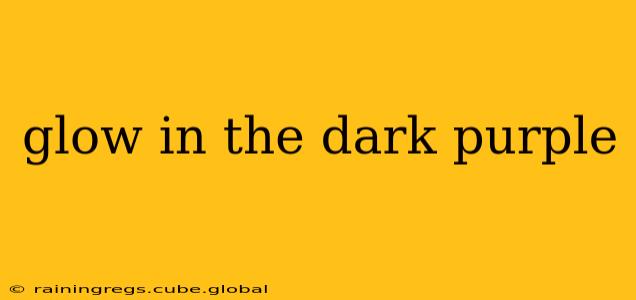The allure of glow-in-the-dark materials is undeniable, and purple, with its regal mystique, adds an extra layer of enchantment. But what makes these materials glow, and what are the options available for achieving a vibrant purple luminescence? This comprehensive guide delves into the science and application of glow-in-the-dark purple pigments, answering your burning questions.
What Makes Something Glow in the Dark?
The "glow" in glow-in-the-dark materials stems from two primary phenomena: fluorescence and phosphorescence. While both result in light emission, they differ significantly in how long the glow persists.
-
Fluorescence: Fluorescent materials absorb light (usually UV light) and immediately re-emit it as visible light. The glow stops as soon as the light source is removed. Think of highlighter ink – it glows brightly under a blacklight but instantly loses its glow when the light is turned off.
-
Phosphorescence: Phosphorescent materials also absorb light, but they release the energy more slowly. This means they continue to glow for a period after the light source is removed, sometimes for hours depending on the material and its exposure to the light source. This is the type of glow typically associated with "glow-in-the-dark" products.
What are the Different Types of Glow-in-the-Dark Purple Pigments?
Achieving a vibrant purple glow requires careful selection of pigments. While pure purple phosphorescent pigments are less common than other colors, they can be created through a blend of other phosphorescent materials. Manufacturers often utilize a combination of:
-
Zinc sulfide-based phosphors: These are commonly used in glow-in-the-dark paints and plastics. Different dopants (added materials) can alter the color of the emitted light. While not inherently purple, blending different doped zinc sulfide particles can achieve a purple hue.
-
Rare earth-doped phosphors: These phosphors, often utilizing elements like europium or terbium, can produce longer-lasting and brighter glows. Again, combinations are often employed to achieve the desired purple shade.
The specific formulation will influence factors like the brightness, duration of the glow, and the exact shade of purple obtained.
How Long Does Glow-in-the-Dark Purple Last?
The duration of the glow depends largely on the type of pigment used and the intensity of the charging light source.
-
Fluorescent purples will only glow while exposed to a light source.
-
Phosphorescent purples offer a varying glow time, ranging from minutes to several hours. The longer the exposure to a bright light source (like sunlight or a strong UV lamp), the longer the material will glow. However, the intensity of the glow will gradually decrease over time.
Where Can I Find Glow-in-the-Dark Purple Products?
Glow-in-the-dark purple products are increasingly available in various forms:
-
Paints: Many craft stores carry glow-in-the-dark paints, although achieving a true purple might require mixing different colors or seeking specialized pigments.
-
Powders and Pigments: Specialty chemical suppliers often offer phosphorescent pigments in bulk, allowing for customized applications.
-
Plastics and Resins: Some manufacturers create glow-in-the-dark plastics and resins incorporating phosphorescent pigments.
-
Clothing and Accessories: You can find glow-in-the-dark purple clothing, shoes, and accessories online or in novelty stores, although the quality and longevity of the glow can vary considerably.
Is Glow-in-the-Dark Purple Safe?
Most commercially available glow-in-the-dark purple products are considered safe for general use. However, it is always advisable to:
-
Check product labels: Look for any warnings or safety precautions.
-
Avoid ingestion: Keep glow-in-the-dark materials away from children and pets.
-
Proper ventilation: If using paints or other materials, ensure adequate ventilation to avoid inhaling any potentially harmful particles.
What is the Best Glow-in-the-Dark Purple for [Specific Application]? (Example: Painting a room, creating jewelry, etc.)
The best glow-in-the-dark purple for a specific application depends entirely on the needs of that application. For painting a room, you might need a high-coverage paint with a decent glow duration. For jewelry, you might prioritize a pigment that produces a bright, long-lasting glow in a small space. Consider factors like:
- Brightness: How bright do you need the glow to be?
- Duration: How long do you need the glow to last?
- Application method: Is it suitable for painting, resin casting, or other methods?
- Cost: Pigments and materials vary considerably in price.
By understanding the science behind glow-in-the-dark materials and carefully considering your specific needs, you can harness the enchanting power of glow-in-the-dark purple in your creative endeavors.
